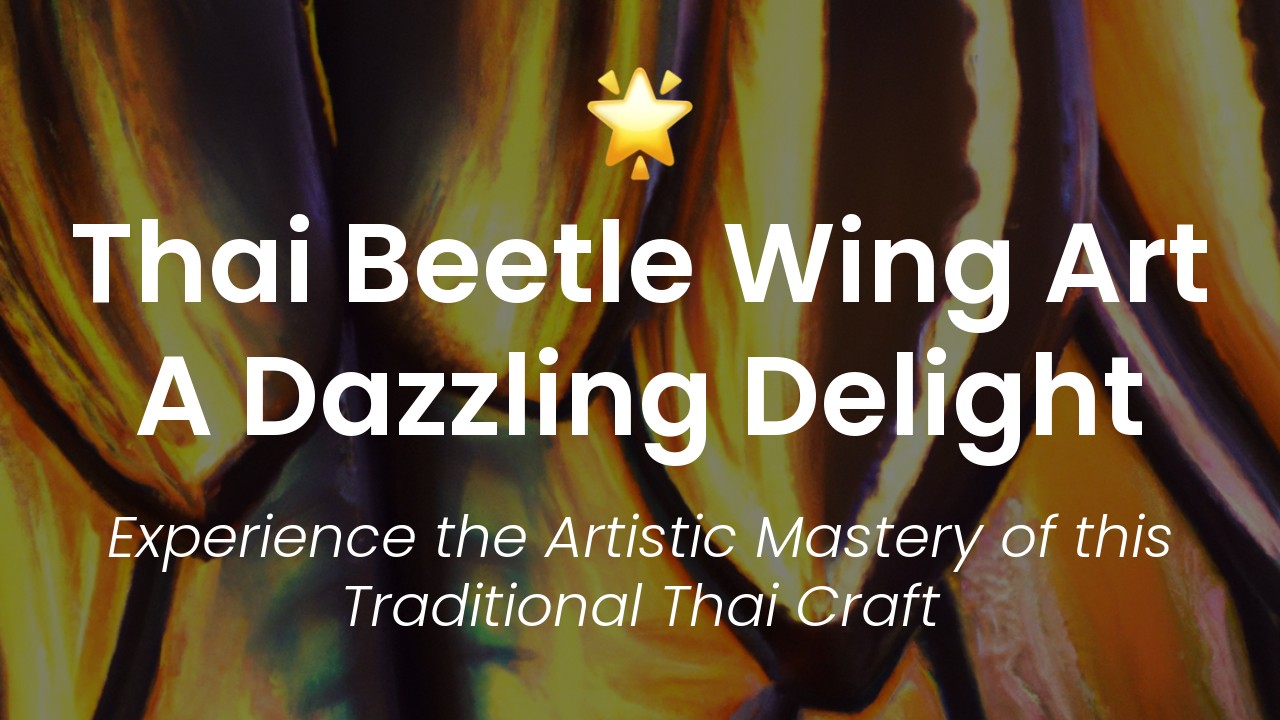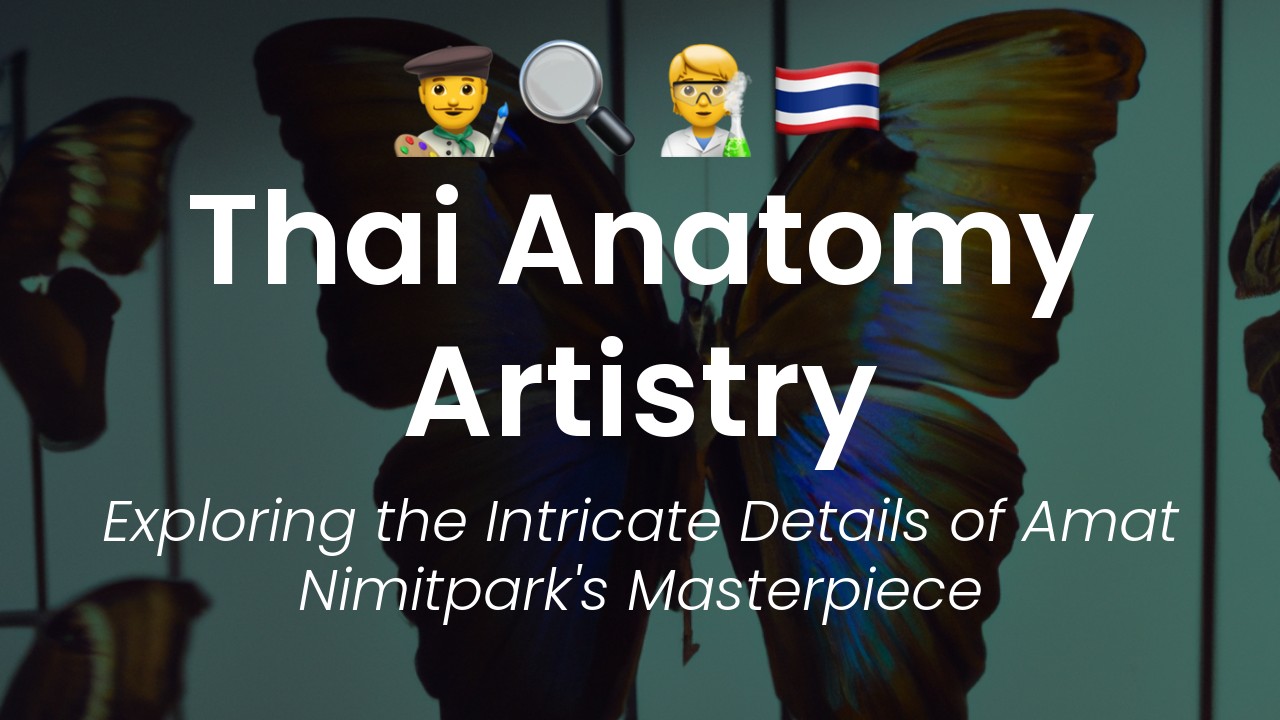Have you ever heard of Thai beetle wing art? It's a unique and intricate form of art that you can find in various temples and palaces in Thailand. As a Thai woman who loves to explore and promote my country's culture, I couldn't wait to write about this dazzling art form in my blog.
Beetle wing art, known as "Kra-jood" in Thai, involves arranging the iridescent wings of jewel beetles into intricate works of art. These tiny wings reflect a rainbow of colors under different lighting conditions, creating a mesmerizing effect that captivates everyone who sees them. The artists who create these pieces spend hours meticulously sorting, gluing, and arranging the wings to create detailed patterns and designs.
This form of art has a long and fascinating history in Thailand. It was particularly popular during the Ayutthaya period (1351-1767), where it was used to decorate important structures and objects associated with the Thai royal court. Eventually, the artform became popular among the general public, and it started being used to decorate household items and clothing accessories. Today, it remains an important part of Thailand's cultural heritage and is admired by people all over the world.
In this article, I'll take you on a journey to discover the beauty of Thai beetle wing art. From its history to how it's made and used today, you'll learn everything you need to know about this unique form of art. Get ready to be dazzled by the iridescence of beetle wings and the skillful hands of Thai artists.
History and Significance of the Art Form
Thai Beetle Wing Art, also known as "Kai Khoon" in Thai language, has been a popular traditional art form in Thailand for centuries. This art form uses beetle wings to create beautiful and intricate designs, which are then used to decorate clothing, accessories, and home décor.
The history of this art form can be traced back to the Ayutthaya period (1351-1767), where it was initially created to adorn the costumes of royal family members and members of the upper class. Beetle wing art was a symbol of high status and prestige, as it was a labor-intensive and delicate craft that required a great deal of time, skill, and effort to produce.
In those days, this art form was also seen as a way to use natural resources in a sustainable and eco-friendly way. Beetles were never killed for their wings; instead, the artisans would collect the wings of dead beetles that they found, and use them to create their artworks.
Today, this art form is still popular in Thailand, but it is no longer exclusive to the upper class. It has become a part of the country's cultural heritage, and many artisans have made it their life's work to keep the tradition alive.
Materials Used in Creating Beetle Wing Art
The primary material used in creating Thai Beetle Wing Art is the wings of the Sternocera aequisignata beetle, which is native to Southeast Asia. These beetles have metallic green wings with yellow and red stripes, which make them a popular choice for this art form.
To create the art, the wings are carefully collected and cleaned, and then arranged in intricate designs that are glued onto a base material such as silk or cotton. The artisans will often use other materials such as gold leaf or sequins to embellish the design further.
Creating a single piece of beetle wing art can take a great deal of time, as the wings are very delicate and must be handled with care. However, the end result is a dazzling display of color and texture that is truly breathtaking.
Traditional Designs and Motifs
Thai Beetle Wing Art features a wide range of traditional designs and motifs that are rooted in Thai culture and symbolism. Some of the most popular designs include lotus flowers, peacocks, and mythical creatures such as the Garuda or the Naga.
Many of these designs have deep cultural and religious significance. For example, the lotus flower is a symbol of purity and enlightenment in Buddhism, while the Garuda is a powerful mythical creature that represents strength and protection.
Traditional motifs are often combined in intricate patterns to create a truly unique and eye-catching design. The use of bright colors and metallic accents adds to the overall beauty and richness of the artwork.
Contemporary Interpretations of Beetle Wing Art
While traditional designs and motifs remain popular in Thai Beetle Wing Art, many contemporary artists are exploring new ways to interpret and innovate this art form. Some are experimenting with new materials, such as feathers or beads, while others are using the wings in more abstract and modern designs.
One artist who has gained international recognition for her Beetle Wing Art is Nualtong Prasarnthong. Her work combines traditional Thai designs with contemporary aesthetics, resulting in stunning pieces that are both beautiful and thought-provoking.
Another contemporary artist, Somsak Sawatdipol, is known for his use of multiple layers and textures in his beetle wing art. By layering the wings and adding other materials such as gold leaf, he creates artworks that are rich and complex, inviting the viewer to explore them in detail.
Where to Find and Purchase Thai Beetle Wing Art
Thai Beetle Wing Art can be found in many markets and souvenir shops throughout Thailand, particularly in tourist areas such as Bangkok or Chiang Mai. However, if you are looking for a high-quality piece, it is best to purchase from a reputable artisan or gallery.
One of the best places to find Beetle Wing Art in Thailand is at the Jim Thompson House Museum in Bangkok. The museum has a large collection of traditional and contemporary pieces, and visitors can also enjoy a guided tour and learn more about the history and significance of this art form.
Another option is to purchase from a certified artisan or group such as the Chiang Mai Creative City network. This network supports local artisans and promotes sustainable and ethical production practices.
Want to learn more about Thai Beetle Wing Art?
If you are fascinated by this glittering art form, please check out the sources below for more information and inspiration.




